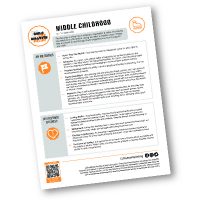
Adolescence
(12+ years old)
Families play a critical role in helping to reestablish a sense of normalcy and safety for a child before, during and after a disaster occurs. Please take a moment to read through these suggestions on how to support your child.
My Milestones
- Bodily Changes: I am noticing changes in my body and developing opinions on how my body looks and functions. Similarly, I may compare my body to other peoples’ bodies: peers’, celebrities’, etc. I may need help understanding the new physical changes that are happening. I may also be beginning to show interest in romantic relationships.
- Performance Matters: My identity is formed especially through how I perform and am viewed socially, which could lead to me dedicating more hours to homework, sports, work, extracurriculars, etc.
- Developing Independent Opinions: While I am learning about the world and my role in it, I am beginning to understand and form my own opinions that may or may not align with yours.
- Long-Term Planning: At this age, I am able to have more complex thoughts and think more abstractly about the world. When thinking about my future, I may begin to think about long-term goals and what I need to do to reach and achieve those goals.
My Response to Stress
- Loss of Interest: It is typical for me to turn down invitations to social gatherings and begin to lose interest in previous hobbies for a short period of time after a very stressful or traumatic experience.
- Stress Management: I am in need of some down-time to de-stress, so you may notice me napping or relaxing more than I would have prior to the disaster or traumatic event.
- Big Emotions: Feelings of worry, guilt, fear, or loss over what happened may increase, and my feelings may even overwhelm me at times. Or, I may feel numb and distant from my emotions.
- Hurtful Comments: I may challenge what you say. I might also say or do hurtful things. Sometimes those comments represent how I feel in the moment, but afterward, I might regret what was said.
How Adults Can Help
- What Happened: Please have an honest conversation with me, and help me process what has happened. Ask me what I know about the event and what TV and my friends are saying about it. Ask me how I feel about it and what questions I have.
- Offer Appropriate Choices: Please provide me with choices, when possible, because that helps me feel more in control of my current situation (for example, what to eat for dinner or if I want to dye my hair a fun color). Continue encouraging me to participate in my favorite hobbies, sports, or other activities.
- Establish A New “Normal” or Routines: While it may not be possible to resume my routines exactly as they were before the disaster, please help me create some consistency or new routines in my day-to-day life.
- Performance Expectations: When it is time for me to go back to school and my regular activities, please be extra patient and kind with me because I may have a hard time performing as well as I used to. If you seem really upset about my performance, that can lower my self-esteem and confidence even more.
- Self-Care: Please take care of yourself. Stay rested, eat well, and drink water. When you are well cared for, then you can take even better care of me.
When to Seek Professional Help
- Unsafe Behaviors: It is typical to engage in some risk taking behavior as I explore my independence from you. If you observe substance abuse, sexually promiscuous behavior, or other risky behaviors, please seek support from emergency services (if an acute crisis) or a healthcare professional (if not a crisis).
- Increase in Mental Health Concerns: If my depression and anxiety levels do not return to what was typical for me before the disaster event, please talk to a healthcare professional or go to your local Emergency Department to seek help during a crisis.
- Self-Harm: If I begin to engage in harmful behaviors that affect myself or others, I need help from a healthcare professional, and will need your assistance in finding that help. Examples of those behaviors include: self-harm, disordered/non-typical eating, threatened or actual harm to others, etc.
About the Authors
Created in collaboration with: Audrey Haugen*, MS, CCLS, and the Child Life Disaster Relief Resource Sub-Committee
Child Life Disaster Relief Resource Sub-Committee:
- Audrey Haugen, MS, CCLS (Chairperson)
- Jean Cooper, CLS, LCSW (CLDR Executive Director)
- Amber Hill, MS, CCLS
- Jordann Hager, MS, CCLS, CPST
- Jennie Kriznik, MPS, CCLS
- Corey Ford, MS, RBT
- Tessa Randolph, BS, CCLS, CGSS
5 Essential Needs for Children Following Disasters
Need more resources? Don't forget to check out our 5 Essential Needs for Children Following Disasters page for more videos, handouts and tips based on the child's age.
